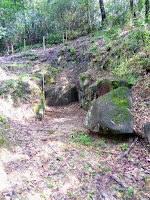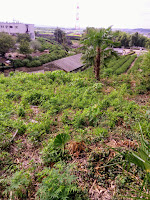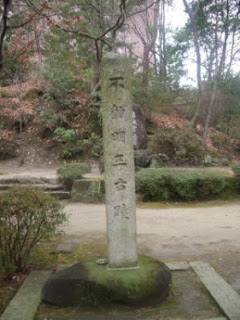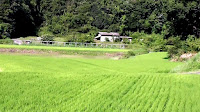During my research for my post - 'The Shrines & Temples of Kyotanabe' - I discovered there was a lot of history attached to this area. I mentioned in the post how Kyotanabe was once the Capitol of Japan (AD511-518). What I also discovered is that there are several Kofun located within the city boundaries.
 |
| Image courtesy of Google Maps. |
 |
| Looking east, towards the Kizugawa River, from the Yakushiyama Kofun. |
My original plan involved checking-out five Kofun - Geshi Kofun, Yakushiyama Kofun, Ino'oka Kurumazuka Kofun, Osumi Kurumazuka Kofun and Osumi Minamizuka Kofun - and maybe a shrine-or-two along the way. And, as always, keeping off the beaten track. But, by the end of the day, I had discovered another two tombs - Gorogoroyama Kofun & Tomb of Motomichi Konoe - and an archaeology museum specializing in artifacts discovered in the Kyotanabe area - Doshisha University.
I was out the door and on my bike at 8am and made a beeline for the settlement of Fugenji, and the Tomb of Motomichi Konoe. This was familiar territory to me as I have passed-through here many times since living in the area. It's a lovely area, especially at this time of year, with the rice-fields a sea of green.
 |
| Map Location. |


I don't know if the two are connected to each other; the staff I spoke to at the museum weren't aware there was a shrine there. Access to Shinguushaya-jinja is via a narrow lane, that ends at the steps to the shrine. The shrine itself looks very new, but the Torii and other structures look considerably older.
After checking-out the site, and taking the obligatory photos, I tried to find a way to the Kofun. The site is surrounded by forest, which adds to the appeal of the shrine, and I began my search for a track which would lead me to my next destination. There were two tracks, the first of which lead nowhere (little did I know it did), and so I took the other.
The second required some bush-bashing. Judging from the terrain, I felt that I was somewhere on the Kofun, and kept my eyes open for a marker of sorts; if you are interested in this style of pursuit, don't do it at this time of year as the insects and cobwebs are bloody annoying. I was wondering if I was ever going to reach my goal, when I looked down and saw a track. I descended and, much to my joy, I had arrived.
 |
| Geshi Kofun. |
The impression I got, is Geshi Kofun (map location) is not so much a burial mound, but a collection of several burial sites, eight in all, (I managed to find six) spread over a small area. The site, I was soon to discover, was located within the Dashisha University Campus.

 |
| Settlement of Inooka (map location). |
From Geshi Kofun, I would make my way to the settlement of Inooka, and an unplanned discovery. Looking at the attached map, Inooka is located on a knob of land, surrounded by rice-fields & tea plantations (above image), and one can't help but get the impression that this site may not be natural, but excavated.
 |
| Yakushiyama Kofun. |
Atop the summit of Yakushiyama Kofun, stands a temple, with a religious icon inside behind a locked gate. The view from the summit, glimpsing through the trees, is awesome (see image at top of page). In front is the Kizugawa River and, in the distance, the town of Ide, at the foot of the Ide Hills.
The impression I got, at the time of my research, was that Yakushiyama & Ino'oka Kofuns were located side-by-side. Wrong, as I was about to discover.
As I was making my departure for my next site, at the settlement of Osumi, I passed this sign, partly camouflaged by trees. A quick check revealed that this is the site of Gorogoroyama Kofun. Okay, this wasn't in my plans. Time to check this out. Parking my bike, I ascended the mound. All there was at the top was a concrete post with something inscribed into it.
 |
| Gorogoroyama Kofun. |
Taking note of this site, so as to apply it to 'Google Maps', I moved on, to another unplanned stop.
As I was weaving my way through the narrow lanes of Inooka, I stumbled-across another sign. The inscription on this read - 'Ino'oka Kurumazuka Kofun. I was become more-and-more intrigued by this place; it seemed every corner I turned, there was another discovery.
A hundred meters or so up the lane from the sign, was an old shed with a track, of sorts, leading up the hill to a clump-of-trees. The track soon petered-out and I found myself weaving my way through, what appeared to have once been, a bamboo grove, now cleared. If I thought my earlier view, from Yakushiyama Kofun, was awesome, the view from here was much better. Looking for a track that may lead me into the trees, and a monument, I literally stumbled-upon these . . . .
 |
| Ino'oka Kofun. |
When I said 'I literally stumbled', I did. If I hadn't tripped myself up on this dead branch, I possible would have missed these two headstones.
It is thought that up to eight or more tombs may be located within the vicinity of Ino'oka Hill and that Emperor Keitai's Son/Prince may be laid-to-rest in one of them.
As the day was beginning to heat-up (it was still only 10am), I decided to take a short break here, take in the surrounding view, before moving-on. While here I decided to take a short detour to the archaeology museum at Doshisha University.
 |
| Site of Tsutsuki Palace. |
I have a special interest in museums, art-galleries, libraries and the like, and I was so pleased that I made the decision to include this on my itinerary. Arriving at the main entrance, a very kind security officer escorted me to the museum; if it had been left to me to find my own way there, I would still be looking now - this is a huge campus.

I was escorted into the room by a member of the staff, who also gave me a tour of the displays and their history. It was like traveling back in time, which is the effect museums can have on one. There were artifacts, excavated from within the Kyotanabe area, that dated back to the Jomon Period (BC14,000-300), on to the Yayoi Period (BC300-AD300) and finishing at the Kofun Period (AD300-538). Pity my Japanese language skills were so poor, I might have been able to have learnt more from my visit.
 |
| Osumi Minamizuka & Osumi Kurumakuka Kofu. |
I departed Doshisha, with the intention of returning (with someone with Japanese language skills) and headed to the settlement of Osumi, and the last two Kofun of my tour - Osumi Minamizuka & Osumi Kurumazuka Kofun (map location). To the casual passer-by, one would get the impression that these were just a couple of clumps of trees in the middle of a rice-field.
Parking my bike, I went off to explore Osumi Minamizuka Kofun, but I needed to find access first. I made my way along a bank that separated two rice fields. Arriving at the site I set-out to explore but there was nothing - no monument or sign - so decided to circumnavigate instead.
To do this, I needed to zigzag my way around through muddy ground (there was no path around the Kofun), remnants of water used for the flooding of the rice-fields. Annoying as it was - I hadn't planned on getting my feet wet - it was quite picturesque. Around the rear was a pond (moat?), surrounded by reeds, with a family of geese enjoying the hot sunny day.
 Returning to my bike, I then headed for Osumi Kurumazuka Kofun. Out of all the Kofun I visited, this was the most distinct. It's 'keyhole' shape stood-out at the base of the trees that covered the mound.
Returning to my bike, I then headed for Osumi Kurumazuka Kofun. Out of all the Kofun I visited, this was the most distinct. It's 'keyhole' shape stood-out at the base of the trees that covered the mound.It was now getting-on to midday, and I had been on the road for four hours, and I still had an hours ride before reaching home. As I hadn't had a bite-to-eat since leaving home, I decided this site was an ideal location to take-on some much needed sustenance.
While doing this I took the opportunity to assess the day and view images taken along the way. My impression is that there is more history to be explored in Kyotanabe, along with it's scenic beauty.
So, until next time,
Sayonara.
I would like to take this opportunity to express my deepest gratitude to Jaroslav, who operates a 'Facebook Page' on 'Japan Kofun'. His invaluable assistance would not have made this post possible.
Course details - https://ridewithgps.com/trips/27238272

































































